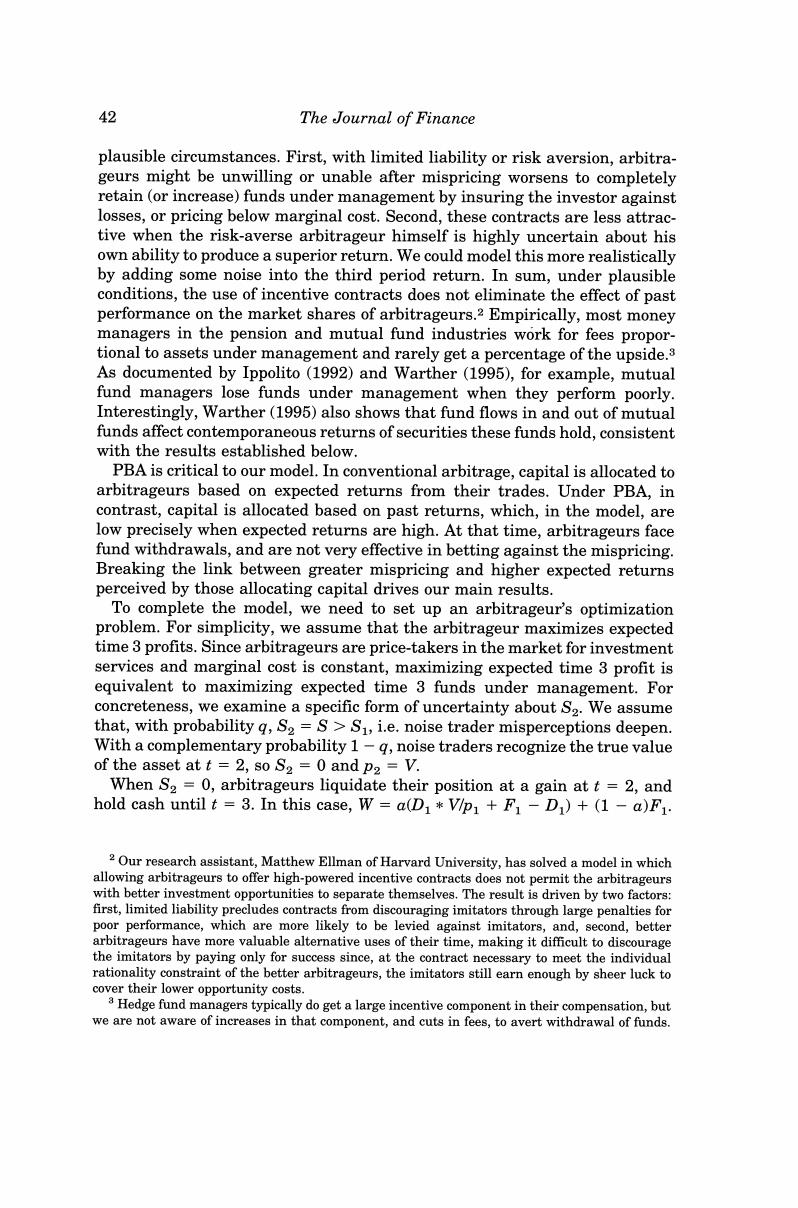正在加载图片...

42 The Journal of Finance plausible circumstances.First,with limited liability or risk aversion,arbitra- geurs might be unwilling or unable after mispricing worsens to completely retain(or increase)funds under management by insuring the investor against losses,or pricing below marginal cost.Second,these contracts are less attrac- tive when the risk-averse arbitrageur himself is highly uncertain about his own ability to produce a superior return.We could model this more realistically by adding some noise into the third period return.In sum,under plausible conditions,the use of incentive contracts does not eliminate the effect of past performance on the market shares of arbitrageurs.2 Empirically,most money managers in the pension and mutual fund industries work for fees propor- tional to assets under management and rarely get a percentage of the upside.3 As documented by Ippolito (1992)and Warther (1995),for example,mutual fund managers lose funds under management when they perform poorly. Interestingly,Warther(1995)also shows that fund flows in and out of mutual funds affect contemporaneous returns of securities these funds hold,consistent with the results established below. PBA is critical to our model.In conventional arbitrage,capital is allocated to arbitrageurs based on expected returns from their trades.Under PBA,in contrast,capital is allocated based on past returns,which,in the model,are low precisely when expected returns are high.At that time,arbitrageurs face fund withdrawals,and are not very effective in betting against the mispricing. Breaking the link between greater mispricing and higher expected returns perceived by those allocating capital drives our main results. To complete the model,we need to set up an arbitrageur's optimization problem.For simplicity,we assume that the arbitrageur maximizes expected time 3 profits.Since arbitrageurs are price-takers in the market for investment services and marginal cost is constant,maximizing expected time 3 profit is equivalent to maximizing expected time 3 funds under management.For concreteness,we examine a specific form of uncertainty about S2.We assume that,with probability q,S2=S>S1,i.e.noise trader misperceptions deepen. With a complementary probability 1-q,noise traders recognize the true value of the asset at t=2,so S2=0 and p2=V. When S2=0,arbitrageurs liquidate their position at a gain at t=2,and hold cash until t 3.In this case,W=a(D*V/p +F-D)+(1-a)F1. 2 Our research assistant,Matthew Ellman of Harvard University,has solved a model in which allowing arbitrageurs to offer high-powered incentive contracts does not permit the arbitrageurs with better investment opportunities to separate themselves.The result is driven by two factors: first,limited liability precludes contracts from discouraging imitators through large penalties for poor performance,which are more likely to be levied against imitators,and,second,better arbitrageurs have more valuable alternative uses of their time,making it difficult to discourage the imitators by paying only for success since,at the contract necessary to meet the individual rationality constraint of the better arbitrageurs,the imitators still earn enough by sheer luck to cover their lower opportunity costs. a Hedge fund managers typically do get a large incentive component in their compensation,but we are not aware of increases in that component,and cuts in fees,to avert withdrawal of funds